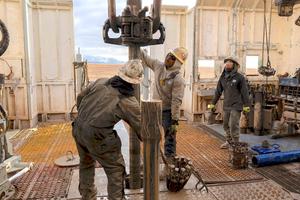Down on the south end of California’s San Joaquin Valley, oil rigs have plumbed the earth like flocks of blackened drinking birds for more than a century. Now, they’re fast becoming vestiges of a bygone era. Kern County still produces nearly three-quarters of the state’s oil and gas, but California’s push to decarbonize its energy grid is putting these rigs and the people who operate them out of work. Their disappearance might come as a death knell to the communities that have long depended on bringing energy up to the surface; but now, those same oilfields could offer new life by sending energy back underground.
Ample sunlight and tens of thousands of abandoned oil wells and experienced oilfield workers have made Kern County the focus of a new battery-storage technology. The plan is to retrofit depleted oil wells to store concentrated solar energy in super-heated groundwater for long periods of time, then use that heat to drive turbines when energy demand rises. If it works as planned, the project — which is being run by the National Renewable Energy Laboratory (NREL) and a private investment group and has been dubbed GeoTES, for geological thermal energy storage — has the potential to overcome some of the renewable energy transition’s greatest hurdles.
Six years ago, California announced one of the world’s most aggressive climate goals: carbon-neutral energy production by 2045. But it soon became clear that producing clean energy would not, by itself, suffice to meet the mark. The sun and wind provide power only when the sun shines and the wind blows, and they sometimes produce too much power for the grid to handle. A full energy transition will require storing that power for when it is needed — whether that is hours, days, or even months from when it is produced.
The project is believed to be the world’s first attempt to store solar energy in a natural geologic reservoir.
Over the last five years, California has increased its energy storage capacity tenfold to more than 10 gigawatts, and on April 16, in a notable first, batteries provided the largest source of supply in the California grid, if only for two hours. This is huge, but it is still a long way from the 52 gigawatts of stored energy that the California Energy Commission predicts the state will need to meet its ambitious climate goals. So far, storage gains have relied on batteries that use lithium, which is in short supply and is often produced in nations known for human-rights and environmental abuses.
Faced with fast-approaching decarbonization deadlines, and the challenges of lithium battery production, the California Energy Commission has earmarked $330 million to develop energy storage alternatives. A wave of nascent technology is storing energy in chemical, electrochemical, and mechanical forms. Like GeoTES, some of these methods also store power as heat but do it in aboveground silos filled with molten salt or sand.
GeoTES offers something different, said Guangdong Zhu, the senior researcher overseeing the long-duration energy storage program at NREL, which focuses on systems capable of retaining power for 10 or more hours. The project is believed to be the world’s first attempt to store solar energy in a natural geologic reservoir, and it aims to store that energy for more than 1,000 hours. “We are looking to find the battery, not build it,” he said.
The GeoTES project occupies a dusty patch of ground nestled between well-plumbed oilfields with hundreds of wells — some idle, some still pumping. Just 1,200 feet below its surface — shallow by drilling standards — are pockets of permeable sandstone, now emptied of oil, into which highly brackish water has seeped.
Like the oil it is replacing, GeoTES begins with the sun. At the surface, parabolic mirrors gather solar energy, which is used to heat a silicon oil flowing through an aboveground loop to 700 degrees Fahrenheit. Comparatively cold groundwater is pumped up, heated by the oil, then sent back down. As long as the sun is shining, the system heats the water in the reservoir. At night, the water continues circulating, maintaining a temperature of about 500 degrees. When called upon to make electricity, the groundwater is brought to the surface through an extraction well, where its heat spins a turbine.
By themselves, none of the pieces that make up GeoTES are cutting edge, Zhu said. “It’s a new concept, but it’s a combination of different mature technologies. It doesn’t require any kind of scientific or material breakthrough.” What is novel is the process of putting them together.
“The basic concept of geothermal heat transfer is used all the time in geothermal heat pump systems in locations around the world,” said Kenneth Gillingham, an environmental and energy economist at the Yale School of the Environment. “Those are proven to be effective and often cost effective, too.”
If the project works and can scale up, it could power Bakersfield’s 300,000 homes for 42 days.
The challenges facing GeoTES are similar to those of geothermal energy generation. Zhu’s team must have a detailed understanding of a reservoir they can’t see — its volume, porosity, thermal conductivity, the nature of its rocks and how well they can trap fluids, and the presence of any leftover hydrocarbons. The system will also have to manage the buildup of dissolved solids on equipment and react to changes within the reservoir that occur over time.
The beauty of GeoTES, according to Zhu, is its use of existing resources: depleted oilfields with natural reservoirs. Crucially, drillers in much of California have enhanced their oilfields by injecting them with steam to force out more oil. This practice requires a detailed understanding of a reservoir’s characteristics, specifically its ability to hold heat — data that the GeoTES team needs. However, these requirements also pose a geographic limitation.
“You need reservoirs with the right characteristics,” Gillingham said. “You need the water to be contained without mixing with groundwater, and [you need] the heat contained. Such reservoirs do exist, but they are not everywhere.”
NREL has been studying how hot water will interact with the reservoir once injected underground, and Premier’s data shows the site is far removed from any drinking or irrigation water. Construction awaits drilling permits and an environmental impact statement. By 2027, Zhu says he hopes the system will generate 100 kilowatts, or enough energy to run about 10 homes for 24 hours. At that capacity, the project’s surface footprint will consist of a half-acre drill pad and a two-acre solar array. Eventually, Zhu and his team hope to scale up to a 400-megawatt system, which will cover nearly 2,000 acres at the surface and circulate within reservoirs with about the same volume as One World Trade Center underground. That $2 billion system could power nearby Bakersfield’s 300,000 homes for 42 days.
Researchers at NREL had been thinking about something like GeoTES for years, but they needed funding and land to make it a reality, which led them to partner with a Kern County-based energy investment firm, Premier Resource Management, in Bakersfield. In 2017, Premier had leased land in the county, hoping to strike crude, but it couldn’t get the necessary permits, said Mike Umbro, a partner in Premier who got his start in the Texas shale fracking boom.
Kern County is home to 28,417 oil and gas wells — 68 percent of the state’s wells — that no longer produce, either because they’ve run dry or their operators have moved on, according to a 2023 report from the Sierra Club. Sitting idle, abandoned wells leak methane and volatile organic compounds, and capping a single well runs about $111,000. Premier hoped to find some life in idle wells, but by 2020, after years of tightening environmental regulations and the passage of its lofty climate goals, California had unofficially quit issuing the permits needed to drill. By then, Premier said it had sunk $800,000 into cleaning up the mess previous oil drillers had left on the site, and Umbro was left wondering, “Do we just scrap this whole thing?”
Instead, Premier’s partners — engineers experienced in managing thermal reservoirs — took a look at their mountain of site-specific thermodynamic data and recognized an opportunity to invest in NREL’s novel geothermal storage idea. By early this year, when California officially announced a ban on new permits for hydraulic fracking, they were fully focused on a way to give the old wells new life — as a battery, of sorts.
To survive a downturn in oil and gas, Kern County aims to reinvent itself as a renewable-energy hub.
In its heyday in the mid-1980s, Kern County produced 256 million barrels of oil a year, and it remains the seventh-largest oil producing county in the U.S. Despite the industry’s harm — more people per capita die from chronic lower respiratory disease here than anywhere else in California — drilling still pumps $13 billion a year into the local economy. Eight of the county’s top 10 taxpayers are energy companies. Bakersfield High School’s mascot is an oil driller. Oil and gas jobs pay an average of about $100,000 a year, which is significant in the farming-heavy San Joaquin Valley, where 20 percent of the population lives below the poverty line.
Like oilfields elsewhere in California, however, Kern’s oilfields have followed a downward trend. Its oil output has fallen to 87 million barrels and its fossil fuels workforce has shriveled from 50,000 in 2015 to 13,770 today as the fracking revolution has sent investment to others parts of the country.
To survive, Kern is investing heavily to reinvent itself as a renewable-energy hub while luring new private ventures with generous tax breaks. Kern is now home to the country’s largest wind farm, and it has plans for a massive solar-powered direct-air carbon-capture facility; the world’s largest standalone solar and lithium-ion battery storage project; and a borax mine with enough lithium in its waste rock to make batteries for 70,000 electric vehicles a year.
State leaders, including Governor Gavin Newsom, have said the transition toward a greener economy should be “just,” meaning, in part, that communities dependent on the oil and gas industry would see alternative sources of income, and workers would be trained for good-paying jobs in renewable industries. In surveys, though, workers across the nation note that the cost and availability of training for wind and solar work remains a barrier to entry and that oilfield jobs still pay better than positions in renewable energy.
A wind farm in Kern County, California, which is seeing interest in renewable energy amid the decline of oil and gas. ZUMA Press, Inc. / Alamy Stock Photo
The geothermal industry would appear to offer a relatively seamless shift for many oilfield workers. Often, contractors can simply apply their skills to hot water instead of oil. As envisioned, GeoTES will use the fossil fuel industry’s drilling data and some of its existing infrastructure, but it will also enlist skilled labor to bore and manage new holes. When Umbro pitches the project to funders and investors, he touts it as a perfect opportunity to transition workers into a decarbonized economy.
GeoTES remains geographically limited and unproven in the field, but the challenge it seeks to solve is widespread and well understood. “If we aim for a deeply decarbonized electricity system with a very high share of renewables, long-duration storage will definitely be a problem,” Gillingham said.
Gabe Murtaugh, director of markets and technology for the Long-Duration Energy Storage Council, a global nonprofit that works to accelerate deployment of long-duration energy storage, cautions that 10-hour energy-storage solutions will help us get through the swing from night to day, but that we produce and consume renewable energy on a scale that spans seasons.
“A 10-hour solution really wouldn’t be enough to carry you through a two-week period in the winter with low solar and low wind output,” Murtaugh said. To fully decarbonize, he and other experts say, we will need a way of holding onto energy for hundreds of hours.
For now, long-duration storage must compete against cheap natural gas and lithium battery technology.
The GeoTES demonstration in Kern County will store renewable energy produced on site, but similar technology could also store excess power from wind and solar farms or even nuclear power plants during times when they produce more electricity than the grid demands. These solutions could address the long-duration problem, but for now, Murtaugh and other say, they must compete against cheap natural gas and better-established lithium battery technology. That is bound to change, though.
“Lithium-ion is probably the cheapest solution if you’re thinking about a four-hour storage solution,” Murtaugh said, but its cost of storage increases linearly with capacity — more storage requires more manufacturing and maintaining more batteries. The earth retains heat extremely well, he said, and once a geothermal storage facility is running, its costs will be relatively flat over longer durations.
Zhu believes the risks of unproven technologies like GeoTES have hindered investment in long-duration storage. Utilities and energy developers have instead leaned toward bringing down the cost of lithium batteries and photovoltaics. So far, only 4 gigawatts of California’s total 52-gigawatt goal for energy storage are slated to be long-duration.
“It’s short sighted to just focus on those dominating technologies without looking into a whole picture,” Zhu said. “If you’re really looking for some technology which can work on the seasonal scale, you don’t have many options.”





